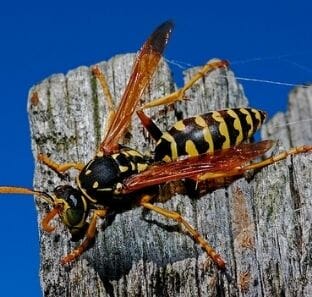Yellow Jackets
Yellow jackets are predatory wasps that typically nest in the ground. They get their name from the yellow and black markings on their bodies. Yellow jackets are often mistaken for bees due to their similar size, shape, and coloring, but closely looking at the yellow jacket wasp reveals they have less hair and lacks the rounded abdomen and long hind legs of pollen-carrying bees.

A single yellow jacket colony may house between 1,500 and 15,000 members. The queen yellow jacket lays her first eggs in the spring after hiding out for the winter alone in a protected place. Typically all the other members of her hive perish in the winter and the queen lives to build a new hive in the spring. She will rear over a thousand adult yellow jackets by the year’s end. A colony may contain 1,000 or more workers by fall. Similar to honeybees, the colony is comprised of sterile female workers with males emerging at mating time.
Here in California, when late summer arrives and everything is crispy dry, yellow jackets hit their peak and the calls from concerned properties owners increase. That’s because food is harder to find and their nests are hitting maximum capacity.
Signs of yellow jacket infestation
Yellow jackets typically nest in the ground, often in abandoned burrows of gophers, moles, voles, and ground squirrels. They also build nests under lifted concrete, in tree hollows, and in other crevices large enough to house the thousands of insects that make up their colony.
Interestingly enough, yellow jackets fly very fast (faster than paper wasps) and erratically. They also have a tendency to hover around food or even in your face.
When yellow jackets nest in close proximity to people, encounters are likely to happen. It is very common for nests to be mowed over or for children and/or pets to stumble upon a nest while playing. The aggressive nature of yellow jackets means they’re likely to attack. Yellow jackets may also invade picnics, BBQs, and other outdoor events where sugary drinks and delicious food attract them.
In the video below, Smith’s Pest Management captured yellow jackets in Palo Alto, California nesting in a rock wall.
Tips for preventing yellow jacket infestations
Good sanitation will help reduce yellow jacket problems. Keeping trash and other food sources sealed up will force yellow jackets to look elsewhere for their meals, and reduce the interactions between people and these wasps.
Filling burrows and holes in your lawn will also eliminate potential nesting sites.
When is it time to take action?
Yellow jackets will swarm anyone or anything that disturbs their hive. Lawn mowers, children’s toys, dogs playing fetch or anything else that inadvertently steps near a yellow jacket hive will cause the workers to swarm and attack by the hundreds. Their sting is painful, and each wasp can give a person multiple stings. Unlike honey bees, yellow jackets can sting repeatedly. Yellow jacket stings may cause dangerous allergic reactions in some people and obviously a LOT of pain.
How Smith’s can help get rid of yellow jackets
At Smith’s Pest Management, we offer effective yellow jacket control for the whole San Francisco Bay area as well as the Monterey Bay area and Sonoma County. When you reach out for help getting rid of yellowjackets, our team will treat ground nests and install bait in order to eradicate wasps that were not in the nest at the time of treatment.
For more details about this service, how it can be combined with other services, or to schedule an appointment, please contact us today.
Bob M. - Fremont, CA
“ The gophers killed my fruit trees, and upended my garden and it became impossible to keep up with them. So I contacted Smith and they took care of them for me.”

